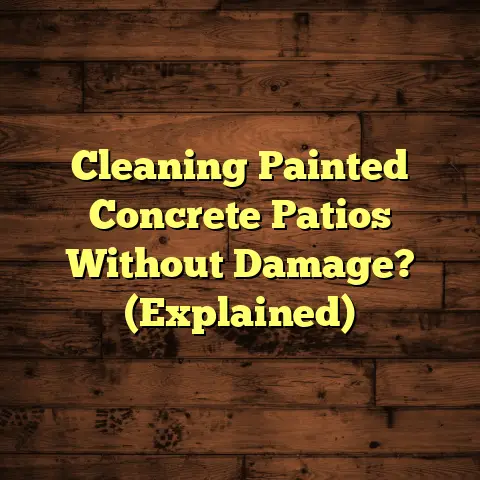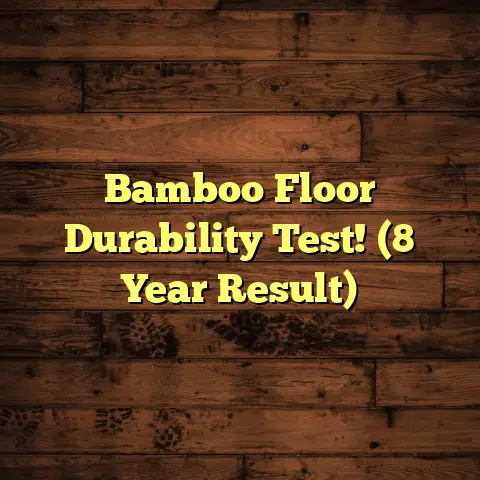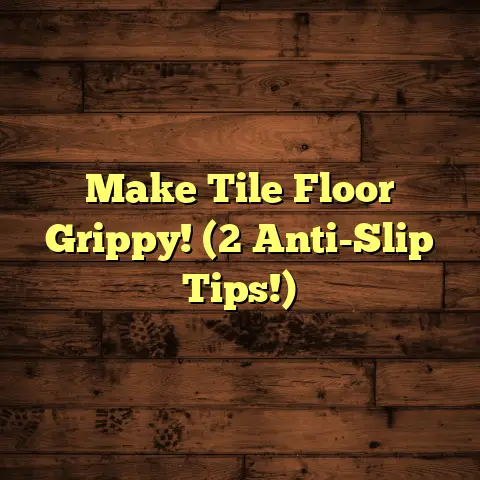Remove Glued Vinyl: The Pro Way (5 Steps!)
Vinyl flooring, it’s been the trendsetter’s choice, right? I mean, who can argue with its versatility, the way it saves your wallet, and how darn good it looks? From those swanky city apartments to cozy suburban homes, vinyl’s been laying the groundwork for style. It’s like the chameleon of flooring, mimicking hardwood and stone without the hefty price tag.
But, let’s be real, trends change, life happens, and sometimes that vinyl just doesn’t vibe anymore. Maybe it’s got some battle scars, or you’re just itching for a fresh look. Whatever the reason, you’re staring at that glued-down vinyl and thinking, “Okay, how do I tackle this?”
Well, buckle up, because I’m going to walk you through the pro way to remove glued vinyl in just five steps. Trust me, with the right know-how, you can handle this like a seasoned pro.
Section 1: Understanding Vinyl Flooring and Adhesives
Before we dive into the nitty-gritty, let’s get familiar with what we’re dealing with.
1.1 Types of Vinyl Flooring
Vinyl flooring isn’t just one big category; it’s more like a family with different members. You’ve got sheet vinyl, which comes in large rolls, perfect for covering big areas with fewer seams. Then there are vinyl tiles, which are, well, tiles! These can be solid vinyl tiles (SVT) or luxury vinyl tiles (LVT), each with its own level of durability and style.
And of course, there’s vinyl plank flooring, which mimics the look of hardwood. Each type is installed a bit differently, but when they’re glued down, the removal process shares some common ground.
1.2 The Adhesive Challenge
Okay, let’s talk glue. This is where things can get tricky. We’re usually dealing with two main types of adhesives:
-
Pressure-Sensitive Adhesives: These are like the sticky notes of the flooring world. They stick with pressure and are often used for vinyl tiles. They can be easier to remove, but don’t underestimate them!
-
Hard-Set Adhesives: Now, these are the heavy-duty glues. They create a strong, permanent bond. Removing vinyl stuck with hard-set adhesives is usually more challenging and time-consuming.
Why is understanding this important? Because knowing what kind of adhesive you’re up against will dictate your removal strategy. Trust me, you don’t want to go in blind!
Section 2: Tools and Materials Needed for Removal
Alright, let’s gear up! Having the right tools makes all the difference. It’s like cooking; you can technically chop veggies with a butter knife, but it’s going to be a whole lot easier (and safer) with a chef’s knife.
2.1 Essential Tools
Here’s your must-have list:
-
Utility Knife: This is your precision instrument. You’ll use it to cut the vinyl into manageable strips. I prefer a knife with snap-off blades so I always have a sharp edge.
-
Floor Scraper: This is your workhorse. It comes in various sizes, but a good, sturdy one with a long handle is key. Trust me, your back will thank you. Look for one with a replaceable blade.
-
Heat Gun or Steam Cleaner: Heat is your ally in softening up that stubborn adhesive. A heat gun gives you focused heat, while a steam cleaner covers a larger area. I personally prefer a heat gun for more control.
-
Pry Bar: For those extra-stubborn sections that just won’t budge, a pry bar will give you that extra leverage.
-
Safety Gear (Gloves, Goggles, Mask): Okay, this isn’t optional. Seriously. You’re dealing with adhesives and potentially dust and debris. Protect yourself! Gloves will protect your hands from the adhesive. Goggles will keep your eyes safe from flying debris. A mask will prevent you from breathing in harmful particles.
2.2 Additional Materials
These aren’t strictly essential, but they can make your life a whole lot easier:
-
Adhesive Remover: There are a ton of adhesive removers on the market. Some are solvent-based, while others are more eco-friendly. I’d recommend testing a small, inconspicuous area first to make sure it doesn’t damage your subfloor.
-
Floor Patching Compound: Chances are, you’ll have some imperfections in your subfloor after removing the vinyl. A floor patching compound will help you smooth things out and create a level surface for your new flooring.
-
Vacuum: For cleanup! You’ll want to suck up all the debris and dust before you start installing your new flooring.
Section 3: Step-by-Step Guide to Removing Glued Vinyl
Alright, let’s get down to business! Here’s the step-by-step process I use to remove glued vinyl like a pro:
3.1 Step 1: Prepare the Area
First things first: clear the space. Move all furniture and appliances out of the room. If that’s not possible, cover them with plastic sheeting to protect them from dust and debris.
Next, ventilation is key. Open windows and doors to get some fresh air circulating. Trust me, you don’t want to be breathing in adhesive fumes all day. If necessary, use a fan to help circulate the air.
And, of course, safety first! Put on your gloves, goggles, and mask.
3.2 Step 2: Test the Adhesive
Before you go all-in, it’s smart to test the adhesive. Find a small, inconspicuous area and try to peel up a corner of the vinyl. If it comes up easily, you’re probably dealing with a pressure-sensitive adhesive. If it’s putting up a fight, it’s likely a hard-set adhesive.
This test will help you determine how much heat and elbow grease you’ll need to apply.
3.3 Step 3: Heat and Loosen the Vinyl
Now, let’s bring on the heat! If you’re using a heat gun, hold it a few inches above the vinyl and move it slowly back and forth. You don’t want to scorch the vinyl or the subfloor. The goal is to soften the adhesive, not melt the flooring.
If you’re using a steam cleaner, run it over the vinyl in sections, allowing the steam to penetrate the adhesive.
Pro Tip: Work in small sections, about 1-2 feet at a time. This will prevent the adhesive from cooling down before you can scrape it up.
3.4 Step 4: Scrape Away the Vinyl
With the adhesive softened, grab your floor scraper and get to work! Hold the scraper at a low angle and push it under the vinyl, using a steady, even pressure.
Pro Tip: If the vinyl is tearing or the adhesive is still stubbornly stuck, apply more heat. Don’t force it! You’ll just end up damaging your subfloor.
For those extra-stubborn areas, use your pry bar for leverage. Be careful not to gouge the subfloor.
3.5 Step 5: Clean Up the Residue
Once you’ve removed all the vinyl, you’ll likely be left with some adhesive residue. This is where your adhesive remover comes in handy. Apply it to the residue according to the manufacturer’s instructions.
Let it sit for the recommended time, then scrape away the softened adhesive. You may need to repeat this process a few times to get rid of all the residue.
Finally, vacuum up all the debris and dust. You want a clean, smooth surface for your new flooring.
Section 4: Common Challenges and Solutions
Okay, let’s talk about some of the curveballs you might encounter. Because, let’s face it, things rarely go perfectly according to plan.
4.1 Dealing with Stubborn Adhesives
Sometimes, no matter how much heat you apply, that adhesive just won’t budge. In these cases, you might need to resort to more aggressive methods.
-
Solvent-Based Adhesive Removers: These are stronger than the eco-friendly versions, but they also have stronger fumes. Make sure you have plenty of ventilation and wear a respirator.
-
Mechanical Removal: If all else fails, you can try using a power scraper or a floor grinder with a diamond grinding wheel. These tools are powerful, but they can also easily damage your subfloor if you’re not careful. I’d recommend hiring a professional for this type of removal.
4.2 Avoiding Subfloor Damage
Speaking of subfloor damage, here are some tips to prevent it:
-
Use the Right Tools: A dull scraper is more likely to damage your subfloor than a sharp one. Make sure your scraper blade is sharp and replace it frequently.
-
Don’t Force It: If the vinyl is stubbornly stuck, don’t try to force it up. Apply more heat or adhesive remover.
-
Use a Low Angle: When scraping, hold the scraper at a low angle to avoid gouging the subfloor.
-
Be Patient: Rushing the job is a surefire way to damage your subfloor. Take your time and work carefully.
Section 5: Final Touches and Preparing for New Flooring
You’ve removed the vinyl, you’ve cleaned up the residue, now what?
5.1 Inspecting the Subfloor
Take a good look at your subfloor. Are there any cracks, holes, or uneven spots? If so, you’ll need to repair them before installing your new flooring.
-
Cracks: Fill small cracks with floor patching compound. For larger cracks, you may need to use a concrete repair mortar.
-
Holes: Fill holes with floor patching compound or a wood filler, depending on the type of subfloor.
-
Uneven Spots: Use a self-leveling compound to create a smooth, level surface.
5.2 Preparing for New Flooring Installation
Once you’ve repaired any damage, it’s time to prepare the subfloor for your new flooring.
-
Clean the Subfloor: Vacuum the subfloor thoroughly to remove any dust and debris.
-
Prime the Subfloor: Apply a primer to the subfloor to improve adhesion and prevent moisture from seeping up into your new flooring.
-
Acclimate Your New Flooring: Allow your new flooring to acclimate to the room’s temperature and humidity for at least 48 hours before installation.
Conclusion
So, there you have it! The pro way to remove glued vinyl in five steps. It might seem like a daunting task, but with the right tools, techniques, and a little patience, you can definitely handle it.
Remember, preparation is key. Make sure you have all the necessary tools and materials before you start. And don’t be afraid to ask for help if you get stuck.
With a little elbow grease and these tips, you’ll be well on your way to a fresh, new floor that you can be proud of. Good luck!





